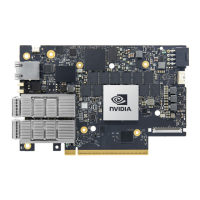•
•
•
•
•
•
•
•
•
•
•
Feature Description
On-board Memory Quad SPI NOR FLASH - includes 256Mbit for Firmware image.
UVPS EEPROM - includes 2Mbit.
FRU EEPROM - Stores the parameters and personality of the
card. The EEPROM capacity is 128Kbit. FRU I2C address is
(0x50) and is accessible through the PCIe SMBus.
DPU_BMC Flashes:
2x 64MByte for BMC Image
512MByte for Config Data
eMMC pSLC 40GB with 30K Write Cycles eMMC for SoC BIOS
and OS.
SSD (onboard BGA) 128GByte for user SoC OS, logs and
application SW.
DDR5 SDRAM - 48GB @5200MT/s dual-channel DDR5 SDRAM
memory. Solder down on-board 128bit +16bit ECC.
BlueField-3 SoC The DPU Controller integrates x16 Armv8.2+ A78 Hercules cores
(64-bit) is interconnected by a coherent mesh network, one DRAM
controller, an RDMA intelligent network adapter supporting up to
400Gb/s, an embedded PCIe switch with endpoint and root
complex functionality, and up to 32 lanes of PCIe Gen 5.0.
RDMA and RDMA overConverged
InfiniBand/Ethernet (RoCE)
The DPU Controller, utilizing IBTA RDMA (Remote Data Memory
Access) and RoCE (RDMA over Converged InfiniBand/Ethernet)
technology, delivers low-latency and high-performance over
InfiniBand/Ethernet networks. Leveraging data center bridging
(DCB) capabilities as well as advanced congestion control
hardware mechanisms, RoCE provides efficient low-latency RDMA
services over Layer 2 and Layer 3 networks.
Storage Acceleration A consolidated compute and storage network achieves
significant cost-performance advantages over multi-fabric
networks. Standard block and file access protocols can
leverage RDMA for high-performance storage access:NVMe
over Fabric offloads for the target machine
The DPU Controller may operate as a co-processor offloading
specific storage tasks from the host, isolating part of the
storage media from the host, or enabling abstraction of
software-defined storage logic using the NVIDIA BlueField-3
Arm cores. On the storage initiator side, the DPU
Controllercan prove an efficient solution for hyper-converged
systems to enable the host CPU to focus on compute while all
the storage interface is handled through the Arm cores.
NVMe-oF and NVMe/TCP Accelerations Non-volatile Memory Express (NVMe) over Fabrics or over TCP are
protocols for communicating block storage IO requests over RDMA
or TCP to transfer data between a host computer and a target
solid-state storage device or system over a network. The DPU
Controller may operate as a co-processor offloading specific
storage tasks from the host using its powerful NVMe Offload
accelerator.
SR-IOV The DPU Controller SR-IOV technology provides dedicated adapter
resources and guaranteed isolation and protection for virtual
machines (VM) within the server.

